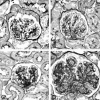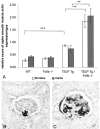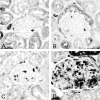Deletion of the fcgamma receptor IIb in thymic stromal lymphopoietin transgenic mice aggravates membranoproliferative glomerulonephritis
- PMID: 12937154
- PMCID: PMC1868251
- DOI: 10.1016/s0002-9440(10)63472-4
Deletion of the fcgamma receptor IIb in thymic stromal lymphopoietin transgenic mice aggravates membranoproliferative glomerulonephritis
Abstract
Engagement of immunoglobulin-binding receptors (FcgammaR) on leukocytes and other cell types is one means by which immunoglobulins and immune complexes activate effector cells. One of these FcgammaRs, FcgammaRIIb, is thought to contribute to protection from autoimmune disease by down-regulation of B-cell responsiveness and myeloid cell activation. We assessed the role of FcgammaRIIb in a mouse model of cryoglobulin-associated membranoproliferative glomerulonephritis induced by overexpression of thymic stromal lymphopoietin (TSLP). TSLP transgenic mice were crossbred with animals deficient for FcgammaRIIb on the same genetic background (C57BL/6). Renal pathology was assessed in female and male animals (wild-type, FcgammaRIIb-/-, TSLP transgenic, and combined TSLP transgenic/FcgammaRIIb-/- mice) after 50 and 120 days, respectively. FcgammaRIIb-/- mice had no significant renal pathology, whereas overexpression of TSLP induced a membranoproliferative glomerulonephritis, as previously established. TSLP transgenic FcgammaRIIb-/- mice appeared sick with increased mortality. Kidney function was significantly impaired in male mice corresponding to aggravated glomerular pathology with increases in glomerular matrix and cellularity. This resulted from both a large influx of infiltrating macrophages and increased cellular proliferation. These results emphasize the important role of FcgammaRIIb in regulating immune responses and suggest that modulation of Fcgamma receptor activation or expression may be a useful therapeutic approach for treating glomerular diseases.
Figures




Similar articles
-
Overexpression of complement inhibitor Crry does not prevent cryoglobulin-associated membranoproliferative glomerulonephritis.Kidney Int. 2004 Apr;65(4):1214-23. doi: 10.1111/j.1523-1755.2004.00495.x. Kidney Int. 2004. PMID: 15086460
-
Cryoglobulinemic glomerulonephritis in thymic stromal lymphopoietin transgenic mice.Am J Pathol. 2001 Dec;159(6):2355-69. doi: 10.1016/S0002-9440(10)63085-4. Am J Pathol. 2001. PMID: 11733384 Free PMC article.
-
Macrophages are essential contributors to kidney injury in murine cryoglobulinemic membranoproliferative glomerulonephritis.Kidney Int. 2011 Nov;80(9):946-958. doi: 10.1038/ki.2011.249. Epub 2011 Aug 3. Kidney Int. 2011. PMID: 21814168
-
Expression and Regulation of Thymic Stromal Lymphopoietin and Thymic Stromal Lymphopoietin Receptor Heterocomplex in the Innate-Adaptive Immunity of Pediatric Asthma.Int J Mol Sci. 2018 Apr 18;19(4):1231. doi: 10.3390/ijms19041231. Int J Mol Sci. 2018. PMID: 29670037 Free PMC article. Review.
-
Thymic stromal lymphopoietin: master switch for allergic inflammation.J Exp Med. 2006 Feb 20;203(2):269-73. doi: 10.1084/jem.20051745. Epub 2006 Jan 23. J Exp Med. 2006. PMID: 16432252 Free PMC article. Review.
Cited by
-
Optimization-by-design of hepatotropic lipid nanoparticles targeting the sodium-taurocholate cotransporting polypeptide.Elife. 2019 Jul 23;8:e42276. doi: 10.7554/eLife.42276. Elife. 2019. PMID: 31333191 Free PMC article.
-
Protease nexin-1, tPA, and PAI-1 are upregulated in cryoglobulinemic membranoproliferative glomerulonephritis.J Am Soc Nephrol. 2008 Feb;19(2):243-51. doi: 10.1681/ASN.2007030367. Epub 2008 Jan 16. J Am Soc Nephrol. 2008. PMID: 18199802 Free PMC article.
-
Imatinib suppresses cryoglobulinemia and secondary membranoproliferative glomerulonephritis.J Am Soc Nephrol. 2009 Jan;20(1):68-77. doi: 10.1681/ASN.2008010036. Epub 2008 Nov 19. J Am Soc Nephrol. 2009. PMID: 19020005 Free PMC article.
-
TLR4 links podocytes with the innate immune system to mediate glomerular injury.J Am Soc Nephrol. 2008 Apr;19(4):704-13. doi: 10.1681/ASN.2007040395. Epub 2008 Feb 6. J Am Soc Nephrol. 2008. PMID: 18256364 Free PMC article.
-
Thymic stromal lymphopoietin transgenic mice develop cryoglobulinemia and hepatitis with similarities to human hepatitis C liver disease.Am J Pathol. 2007 Mar;170(3):981-9. doi: 10.2353/ajpath.2007.060474. Am J Pathol. 2007. PMID: 17322382 Free PMC article.
References
-
- Liszewski MK, Farries TC, Lublin DM, Rooney IA, Atkinson JP: Control of the complement system. Adv Immunol 1996, 61:201-283 - PubMed
-
- Ravetch JV, Luster AD, Weinshank R, Kochan J, Pavlovec A, Portnoy DA, Hulmes J, Pan YC, Unkeless JC: Structural heterogeneity and functional domains of murine immunoglobulin G Fc receptors. Science 1986, 234:718-725 - PubMed
-
- Clynes R, Ravetch JV: Cytotoxic antibodies trigger inflammation through Fc receptors. Immunity 1995, 3:21-26 - PubMed
-
- Amigorena S, Bonnerot C, Drake JR, Choquet D, Hunziker W, Guillet JG, Webster P, Sautes C, Mellman I, Fridman WH: Cytoplasmic domain heterogeneity and functions of IgG Fc receptors in B lymphocytes. Science 1992, 256:1808-1812 - PubMed
Publication types
MeSH terms
Substances
Grants and funding
LinkOut - more resources
Full Text Sources
Other Literature Sources
Molecular Biology Databases

